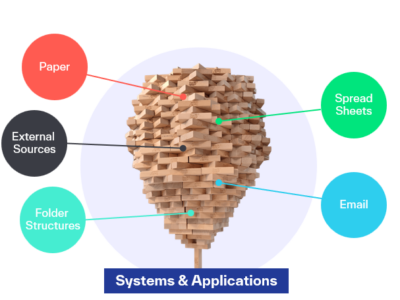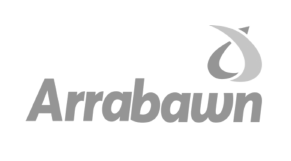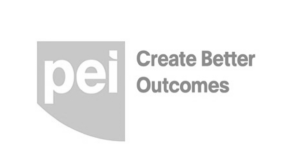
Dark Data and Content Chaos
In today’s rapidly changing business landscape, effective document and information management is no longer a “nice to have” but a fundamental necessity that delivers huge competitive advantages. However, organisations are facing a persistent challenge: the disconnection of information and related content chaos and sprawl across paper, spreadsheets, systems, folders, emails, and other repositories such as Dropbox, Google Drive and WhatsApp. This disconnection isn’t confined to individual departments but extends to inter-departmental communications, leading to inefficiencies, errors, and wasted time.
Understanding Dark Data and Content Chaos
The widely used term ‘Dark Data’ is used to describe all the documents, information and data that are “Dark”. By “Dark” we mean hidden from view, hard to find, trust that they’re the correct version and certainly not possible to use for workflow automation or reporting. In many cases organisations aren’t even aware of the extent of Dark Data because documents and information are badly named at the bottom of some network folder tree or trapped in a spreadsheet or on a piece of paper in a filing cabinet or duplicated in lots of different systems.
Dark Data results in ‘Content Chaos’, a state of chronic disorganisation and information sprawl where information is stored in lots and lots of different locations.
Dark Data and Content Chaos carries a huge burden and cost to business.
So, what are the causes?
Paper:
The fact that we still rely so heavily on paper in a world dominated by digital approaches is mind boggling. That said, paper should be considered a symptom rather than a cause, if paper is heavily relied upon it suggests that paper is probably the best and only solution to moving information around the organisation.
Paper shouldn’t be part of business or operational strategies. It is not secure, it is cumbersome, and increasingly incompatible with modern business practices.
When we automate manual processes, the paper trail disappears in favour of business process automation best practices. If your business is still reliant on the use of paper to any degree, you need to look at automating your processes.
Spreadsheets:
While spreadsheets are excellent tools for specific tasks, their misuse as de facto databases for actionable business data are problematic. Issues which range from manual entry errors to difficulty in collaboration and data corruption is all too easy. When spreadsheets are ‘adapted’ for uses never intended, they are not dynamic, dependable, accessible, or resourceful. Businesses laden with spreadsheets are immediately vulnerable to the pitfalls of disconnected information.
Whilst the use of spreadsheets signifies disconnected information and processes, it does signal that a business is using them to try and find a better way of operating, so these organisations tend to be extremely positive when they see much better alternatives to spreadsheets.
External Sources
The widespread use of Dropbox, Google Drive and even communication platforms such as WhatsApp is more common that we like to admit. But like spreadsheets it is an example of users trying to improve how they work largely due to the absence of the correct tools. Once any business information is stored or shared using external sources, your business is no longer in control. You can’t impose basic rules around permissions, version control and history because you are beholden to the software provider. Process automation is impossible because these platforms are intended for a singular purpose making them redundant when it comes to the workflow flexibility that is paramount for today’s business world.
Email, while essential, often becomes another source of information silos, and a big one! It is not always easy to link or relate emails to specific assets, tasks, suppliers, customers, or projects therefore they tend to sit in our inboxes or email folders thus increasing the Dark Data problem literally email by email.
And with the sheer volume of emails being sent and received, the use of CC and BCC and trying to establish if you are actually being asked to complete a task related to a process or are you just included along with the other 30 people copied on the email!!!
And of course, with the departure of an employee what do you do with their emails? It’s impossible to wade through their emails and identify information that is business critical or not. So, as a result these emails tend to stay where they are, and organisations hope that there is nothing important or critical sitting there….more Dark Data!
However, there are effective solutions for managing email more efficiently within the organisational framework.
Network Folders and Share Drives
Unless a business has already implemented proper connected information strategies and business process automation, we can guarantee that there is not a single business out there that doesn’t rely on folders and has difficulty finding files (and folders!).
And the root cause? Documents are stored in folders. And people can’t find them. They can’t find them because they need to know where they are – it’s a location-based storage. Where did such and such store the document I am looking for? Or where should I put this document so that others can find it? It’s a sales proposal for a customer so should it go in the sales folder or customer folder? Well technically both but then you have two versions and when someone else accesses the document how do they know they are working on the correct version?
This goes to the very basics of finding and accessing the correct version of information.
And another issue we see with folders, is the inability to enforce standardisation on naming conventions of files. So, the user has control, and it results in file names such as JPEG.1 or Scan and todays date. Another reason Dark Data exists.
So, you need to find a way of saving information so it can be easily found, is the correct version and is named correctly.
Systems
While systems are essential for business operations, disconnected systems create silos and inefficiencies. And when evaluating a system during the procurement process, the decision-making analysis needs to be expanded beyond just the department and required functionality but across the whole business to ensure the huge cost and risk of disconnection is avoided.
- It’s vital to know what information it will store and where it will store it?
- Does that information already exist somewhere else in the organisation, or could it be used to improve another business process?
- You should also consider that if a system was implemented, would it solve some problems but create others in other parts of the business.
The key point is that lots of disconnected systems are bad for business and lead to huge inefficiencies, manual interventions and Dark Data duplication. The key for business is to adopt a strategic approach to systems and managing information, instead of the typical functional approach that creates boundaries to information flow.

The Impact of Disconnected Information
Without a strategic approach to managing information, businesses suffer from information sprawl and content chaos. IDC reports that knowledge workers spend about 30% of their day searching for information, only finding it 56% of the time. This inefficiency carries an enormous cost to business and hinders automation potential and accurate reporting.
Building an Information Foundation Fit for Purpose
Addressing these challenges requires a strategic approach to information management. By acknowledging and addressing the root causes of information disconnects, businesses can streamline their processes, enhance decision-making capabilities, and focus their teams on high-value tasks. The goal is not just to automate but to create a resilient information ecosystem, where data is not just stored but actively managed and utilised.
Is Dark Data and Content Chaos disrupting your business ? Contact us via info@convergent.ie and lets talk.















